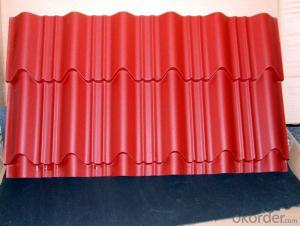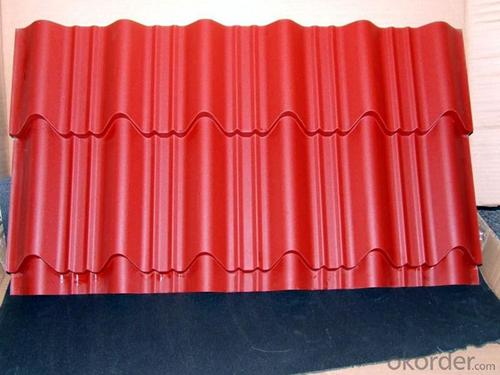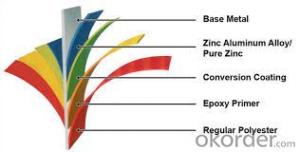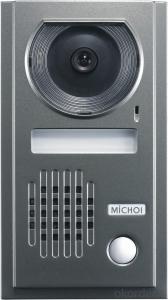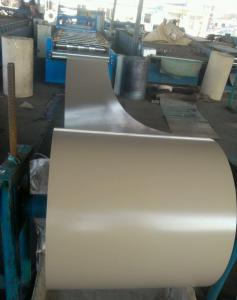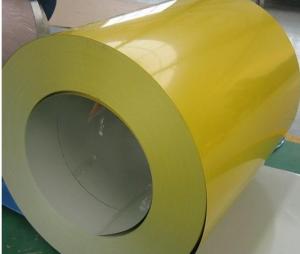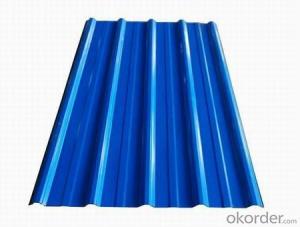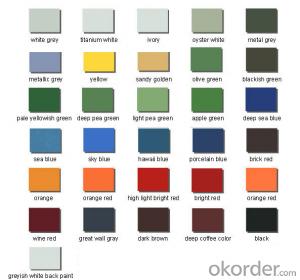PE,PVDF,HDP OR SMP Color Coated Sheet/PPGI
- Loading Port:
- Tianjin
- Payment Terms:
- TT OR LC
- Min Order Qty:
- 25 m.t.
- Supply Capability:
- 50000 m.t./month
OKorder Service Pledge
OKorder Financial Service
You Might Also Like
Specification
PE,PVDF,HDP OR SMP Color Coated Sheet/PPGI
1. Detailed Specifications:
| Product | PE,PVDF,HDP OR SMP Color Coated Sheet/PPGI |
| Base material | Hot dipped galvanized steel sheet |
| Top side: | 15-25µm |
| Back side | 5-8µm |
| Zinc coating : | 30-150g/m2 |
| Width | 700-1250mm |
| Thickness | 0.3-1.0mm , Thickness tolerance: +/- 0.02mm |
| Technique | Cold rolled—>hot dipped galvanized |
| Color | All RAL color,or be customized |
| Coil ID | 508m&610mm |
| Coil weight | ≤5 tons |
| Packing | standard seaworhty package |
| Special specifications can be negotiated. | |
2. Application:
They are mainly used in construction ,light industry, automobile, agriculture, animal husbandry, fishery and commerce,etc industries.
(1) manufacture anticorrosion, industrial and roof boarding,roof grille.
(2) Make home appliance’s case, civil chimney, kitchen utensils.
(3) Corrosion resistant parts of cars.
(4) Food storage, meat and aquatic products’ freezing and processing equipment.
(5) The equipments to store and transport materials, and packing implements.
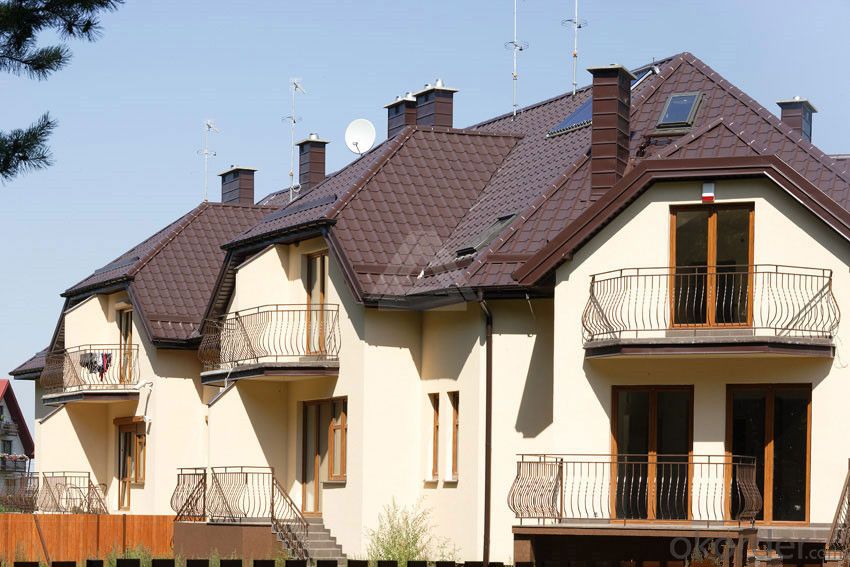
3. Image:
production Line:
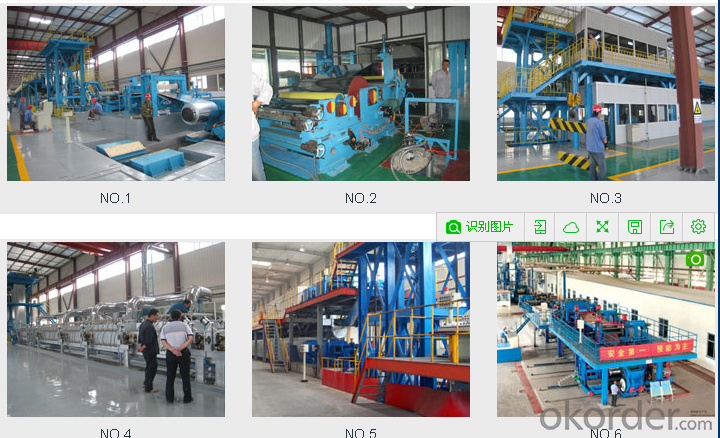
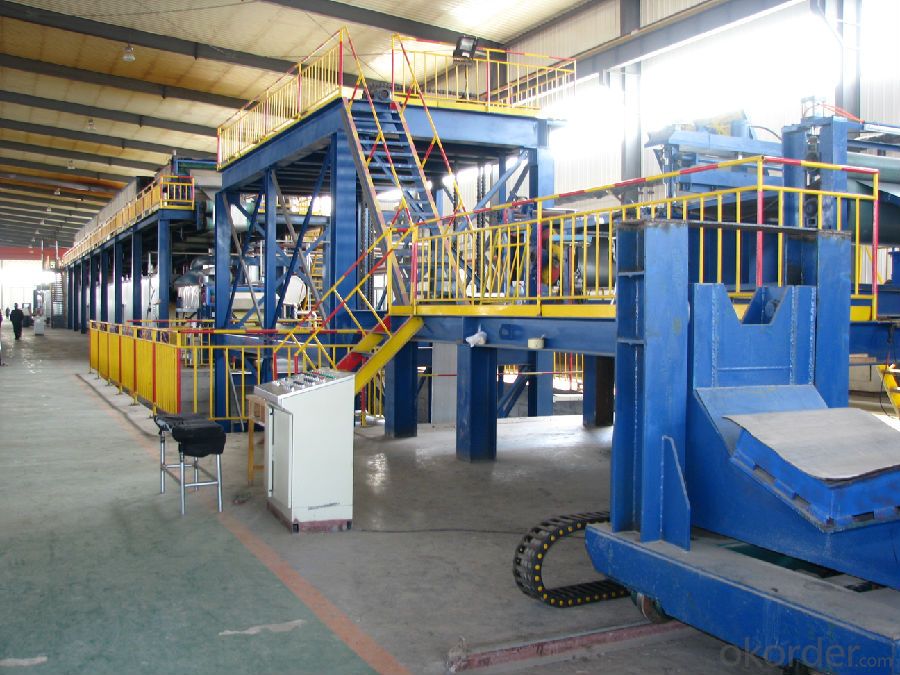
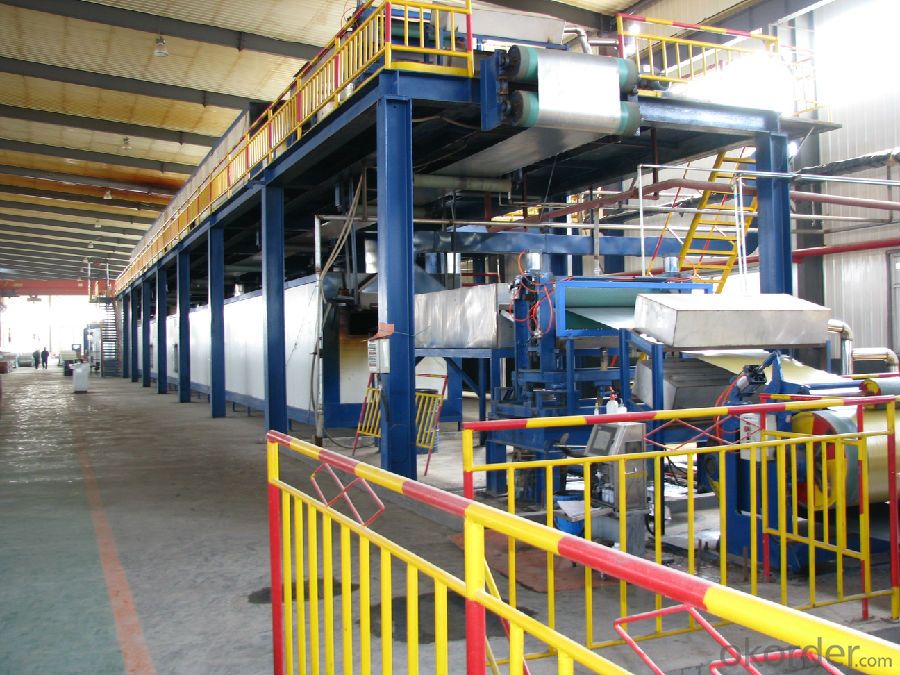

production show:
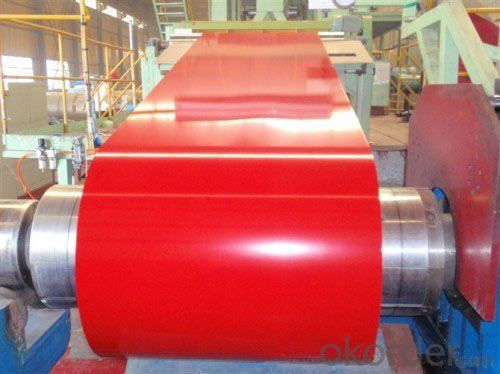
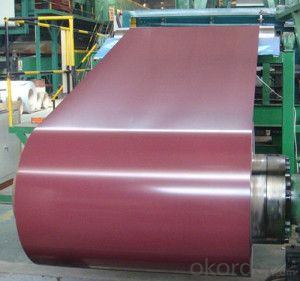
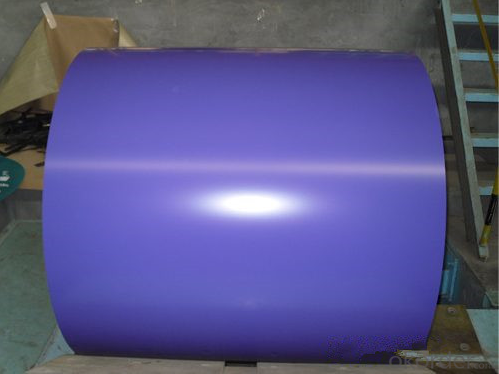
4.Packaging & Delivery
(1)Metal Band Strapping (2) Outside Diameter Ring (3) Label
(4)Protective Steel Sheet (5) Water and Rustproof paper (6)Steel Sheet

5.RFQ
We have organized several common questions for our clients,may help you sincerely:
①How about your Warranty?
Warranty:
1Year for the whole light. Warranty is based on correct storage, installation, using and mainten anc.
②How to guarantee the quality of the products?
We have established the international advanced quality management system, every link from raw material to final product we have strict quality test; We resolutely put an end to unqualified products flowing into the market. At the same time, we will provide necessary follow-up service assurance.
③How long can we receive the product after purchase?
In the purchase of product within three working days, We will arrange the factory delivery as so on as possible.
- Q: How are steel coils inspected for surface finish?
- Steel coils are typically inspected for surface finish using visual inspection techniques and specialized equipment such as surface roughness testers, gloss meters, and profile scanners. These methods help to assess the coil's smoothness, texture, and appearance, ensuring it meets the required surface finish specifications.
- Q: Are steel buildings or homes better then wooden buildings? Why?
- Arch steel buildings are extremely easy to put up as compared to other conventional structures you don't need any type of heavy equipment to erect your steel arch buildings. Most of the people put their steel buildings up with the help of family or friends in just a couple of days.
- Q: why were guns, germs and steel absent within America?
- i dont really understand this question but if it means to how it was before then it was absent because the native americans were not into technology so they obviously had no guns created that was something that they had traded to get from europe as for the germs i ddo not know about thta really except for if it means that common disease and one of the diseases most used in history books is malaysa from mosquitos but when they had traded with europe they got all sorts of diseases now for steel the only reason i remember them traveling for is for gold and i dont remember them ever looking for it until 13 colonies were established as you can see im not exactly sure about germs and steels but i know that the guns part is correct
- Q: How do steel coils compare to other materials like aluminum or copper?
- Steel coils have distinct advantages over materials like aluminum or copper in certain applications. Steel is generally more affordable, readily available, and has higher tensile strength compared to aluminum or copper. It also offers better resistance to corrosion and is highly durable, making it suitable for heavy-duty applications. However, aluminum and copper have their own unique properties that make them preferable for specific uses, such as electrical conductivity or lightweight construction. Ultimately, the choice between steel coils and other materials depends on the specific requirements and intended application.
- Q: How are steel coils used in the manufacturing of metal furniture?
- Steel coils are an essential component in the manufacturing of metal furniture. These coils are typically made from high-quality steel, which provides strength, durability, and stability to the furniture. The first step in using steel coils in the manufacturing process is to cut them into the desired length and width. This is done using specialized machinery and tools, ensuring precise and accurate dimensions for the furniture components. Once the coils are cut, they are then shaped and formed into various furniture parts such as chair frames, table bases, or cabinet structures. The coils can be bent, welded, or manipulated to create the desired shapes and designs. After the shaping process, the steel coils are further processed to enhance their aesthetic appeal and protection against corrosion. This involves sanding, polishing, and applying protective coatings or finishes to give the furniture a smooth and attractive surface. In addition to providing structural support and visual appeal, steel coils also contribute to the overall functionality of metal furniture. They offer excellent load-bearing capacity, ensuring that the furniture can withstand weight and pressure without bending or breaking. Moreover, steel coils make metal furniture more resistant to wear and tear, making it suitable for both indoor and outdoor use. They can withstand harsh weather conditions, making them ideal for patio furniture or outdoor seating arrangements. Overall, steel coils are indispensable in the manufacturing of metal furniture, playing a crucial role in providing strength, durability, and aesthetic appeal. Their versatility and reliability make them a preferred choice for furniture manufacturers worldwide.
- Q: How are steel coils inspected for thickness using ultrasonic testing?
- Ultrasonic testing is employed to inspect the thickness of steel coils, utilizing a non-destructive method. When conducting this process, a handheld ultrasonic thickness gauge is utilized to determine the thickness of the coil. The ultrasonic thickness gauge emits high-frequency sound waves that travel through the steel coil. These sound waves rebound from the opposite side of the coil, generating an echo. The time it takes for the echo to return to the gauge is measured and utilized to compute the coil's thickness. The gauge comprises a transducer responsible for emitting the sound waves and a receiver that detects the echoes. To ensure optimal acoustic contact between the transducer and the steel surface, the transducer is placed on the coil's surface, utilizing a coupling gel or oil. The transducer releases a brief burst of sound waves, which penetrate through the steel coil and reach the opposite side. If the sound waves encounter any variations or defects in the coil's thickness, they reflect back to the transducer. These echoes are detected by the receiver, and the time between the emission and reception of the sound waves is measured. By utilizing the known speed of sound in steel, the time taken for the sound waves to traverse the coil and return can be converted into a thickness measurement. This enables an accurate evaluation of the steel coil's thickness at different points. Ultrasonic testing is a dependable and efficient method for inspecting the thickness of steel coils. It permits swift measurements without causing any harm to the material, thereby making it ideal for quality control purposes and ensuring compliance with manufacturing specifications.
- Q: would you consider steel a flexible substance...i am debating this with my coworkers.Thanks,
- Yes, looking at it from an engineering standpoint. Depending on it's shape it can be used for many applications where flexibility is important. Steel springs for example, or guitar strings. Whenever you're debating these kinds of matters, it is important to keep in mind that the use of a material depends on the shape, the size and the weight it's going to be used in. A big block of steel will be used in a different manner as a piece of steel wire.
- Q: How do steel coils contribute to the sustainability of construction projects?
- There are several ways in which steel coils contribute to the sustainability of construction projects. First and foremost, steel is a highly durable and long-lasting material. Manufactured to withstand extreme weather conditions, corrosion, and other external factors, steel coils are ideal for construction projects that require strength and longevity. This durability reduces the need for frequent repairs and replacements, resulting in minimized waste and resource consumption over time. Moreover, steel coils are recyclable. Once their lifespan in a construction project comes to an end, steel coils can be easily and efficiently recycled. This recycling process requires less energy compared to the production of new steel, leading to reduced carbon emissions and environmental impact. Furthermore, the recycled steel can be utilized in various industries, including construction, thereby promoting sustainability and resource conservation. Additionally, steel coils contribute to the sustainability of construction projects by offering design flexibility. Being a versatile material, steel can be easily shaped, cut, and molded into different forms and sizes. This allows for efficient construction practices, reducing material wastage and optimizing resource utilization. Furthermore, the lightweight nature of steel coils enables convenient transportation and installation, further decreasing fuel consumption and associated greenhouse gas emissions. Lastly, steel coils contribute to the sustainability of construction projects through their energy efficiency. Being an excellent conductor of heat and electricity, steel is ideal for energy-efficient buildings. By incorporating steel coils into the construction of walls, roofs, and other components, buildings can be effectively insulated, resulting in reduced energy consumption for heating and cooling. Consequently, occupants benefit from lower energy bills, while the overall carbon footprint of the construction project is reduced. In conclusion, steel coils contribute to the sustainability of construction projects through their durability, recyclability, design flexibility, and energy efficiency. By utilizing steel coils, construction projects can minimize waste, conserve resources, reduce environmental impact, and optimize energy consumption, thereby promoting a more sustainable and eco-friendly approach to construction.
- Q: How do steel coils contribute to sustainability in manufacturing?
- Steel coils contribute to sustainability in manufacturing in several ways. Firstly, steel is a highly recyclable material, meaning that steel coils can be easily recycled and reused, reducing the need for new steel production and conserving natural resources. Additionally, steel is known for its durability and strength, resulting in longer-lasting products and reduced waste. Steel coils also play a vital role in energy-efficient manufacturing processes, as they can be easily formed into various shapes and sizes, optimizing material usage and minimizing energy consumption. Furthermore, steel's versatility makes it suitable for a wide range of applications, allowing manufacturers to create more sustainable products across industries. Overall, steel coils contribute to sustainability by promoting resource conservation, waste reduction, energy efficiency, and the production of durable and eco-friendly products.
- Q: I am making a permanent magnet, just for fun. I am trying to find the best grade of steel to do so with.
- The type of steel you require is Steel ( Iron + Carbon, mainly.),{many different types of steel } with a high Cobalt and Nickel content. These alloyed together give the best Permanent Magnets, mainly due to their own individual magnetic properties / characteristics being retained in the Alloy. All 3 metals can be magnetised by there own, but Cobalt is known to cause cancer. Nickel, is poisonous and can also cause sever Dermatitis and the destruction of skin tissue.But when alloyed together with Iron they are pretty harmless. Interesting thing is, All of these metals (in this case Elements) can share the same Mass Number ( 60 ). And yet are totally different in their other properties beside Magnetism. Cobalt - Samarium - alloys, create some of the worlds most powerful permanent magnets. And were used in medicine, But are now superseded by Neodymium magnets which are employed instead. Edit; What you could try is, mild steel which is widely available and easily found. . The steels mentioned above are pretty exclusive materials and I personally would not know how to test for their contents, of which they are made from. Soft Iron is good for making electro-magnets if you fancy a go at making one. .
Send your message to us
PE,PVDF,HDP OR SMP Color Coated Sheet/PPGI
- Loading Port:
- Tianjin
- Payment Terms:
- TT OR LC
- Min Order Qty:
- 25 m.t.
- Supply Capability:
- 50000 m.t./month
OKorder Service Pledge
OKorder Financial Service
Similar products
Hot products
Hot Searches
Related keywords
